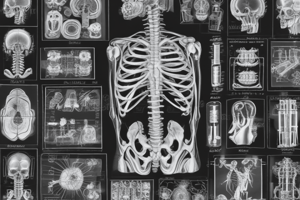Podcast
Questions and Answers
Which of the following is NOT a patient-related fault?
Which of the following is NOT a patient-related fault?
- Inadequate patient preparation
- Incorrect kVp or mA settings
- Incorrect patient positioning
- Detector or sensor malfunction (correct)
What is the consequence of radiographic faults on patient care?
What is the consequence of radiographic faults on patient care?
- Improved image quality
- Increased patient satisfaction
- Diagnostic errors and decreased patient satisfaction (correct)
- Decreased healthcare costs
What is the purpose of quality control measures?
What is the purpose of quality control measures?
- To reduce healthcare costs
- To reduce patient radiation exposure
- To improve image resolution
- To ensure equipment functionality and performance (correct)
Which of the following is an equipment-related fault?
Which of the following is an equipment-related fault?
What is the result of inadequate beam alignment?
What is the result of inadequate beam alignment?
What is a consequence of repeat examinations?
What is a consequence of repeat examinations?
Which of the following is a technique-related fault?
Which of the following is a technique-related fault?
What is the result of processing errors?
What is the result of processing errors?
Flashcards are hidden until you start studying
Study Notes
Radiographic Faults
Radiographic faults refer to errors or anomalies that occur during the radiographic process, resulting in inadequate or misleading images. These faults can be classified into three main categories:
Patient-related faults
- Incorrect patient positioning: Failure to position the patient correctly, leading to inadequate visualization of the area of interest.
- Inadequate patient preparation: Failure to prepare the patient properly, such as not removing radiopaque objects or not following proper bowel preparation protocols.
- Patient movement: Movement during the exposure, resulting in blurred or distorted images.
Technique-related faults
- Incorrect kVp or mA settings: Inappropriate selection of kVp or mA settings, leading to underexposure or overexposure of the image.
- Incorrect exposure time: Inadequate or excessive exposure time, resulting in poor image quality.
- Inadequate beam alignment: Failure to align the X-ray beam correctly, resulting in distorted or asymmetric images.
Equipment-related faults
- Faulty X-ray tube: Malfunctioning X-ray tube, resulting in inconsistent or inadequate radiation output.
- Detector or sensor malfunction: Failure of the digital detector or sensor, resulting in poor image quality or artefacts.
- Processing errors: Errors during image processing, such as incorrect algorithm selection or software glitches.
Consequences of radiographic faults
- Diagnostic errors: Inadequate or misleading images can lead to incorrect diagnoses or delayed diagnosis.
- Repeat examinations: Radiographic faults may require repeat examinations, increasing patient radiation exposure and healthcare costs.
- Decreased patient satisfaction: Radiographic faults can lead to patient discomfort, anxiety, and dissatisfaction.
Prevention and correction
- Quality control: Regular quality control measures to ensure equipment functionality and performance.
- Technician training: Ongoing training and education for radiographic technicians to ensure proper technique and protocols.
- Image review: Careful review of images to identify and correct faults before presenting them to the radiologist or clinician.
Radiographic Faults
- Radiographic faults are errors or anomalies that occur during the radiographic process, resulting in inadequate or misleading images.
Patient-related Faults
- Incorrect patient positioning leads to inadequate visualization of the area of interest.
- Inadequate patient preparation includes not removing radiopaque objects or not following proper bowel preparation protocols.
- Patient movement during exposure results in blurred or distorted images.
Technique-related Faults
- Incorrect kVp or mA settings lead to underexposure or overexposure of the image.
- Inadequate or excessive exposure time results in poor image quality.
- Inadequate beam alignment leads to distorted or asymmetric images.
Equipment-related Faults
- A faulty X-ray tube results in inconsistent or inadequate radiation output.
- Detector or sensor malfunction results in poor image quality or artefacts.
- Processing errors include incorrect algorithm selection or software glitches.
Consequences of Radiographic Faults
- Diagnostic errors can occur due to inadequate or misleading images.
- Repeat examinations increase patient radiation exposure and healthcare costs.
- Radiographic faults can lead to patient discomfort, anxiety, and dissatisfaction.
Prevention and Correction
- Regular quality control measures ensure equipment functionality and performance.
- Ongoing training and education for radiographic technicians ensure proper technique and protocols.
- Careful review of images identifies and corrects faults before presenting them to the radiologist or clinician.
Studying That Suits You
Use AI to generate personalized quizzes and flashcards to suit your learning preferences.




